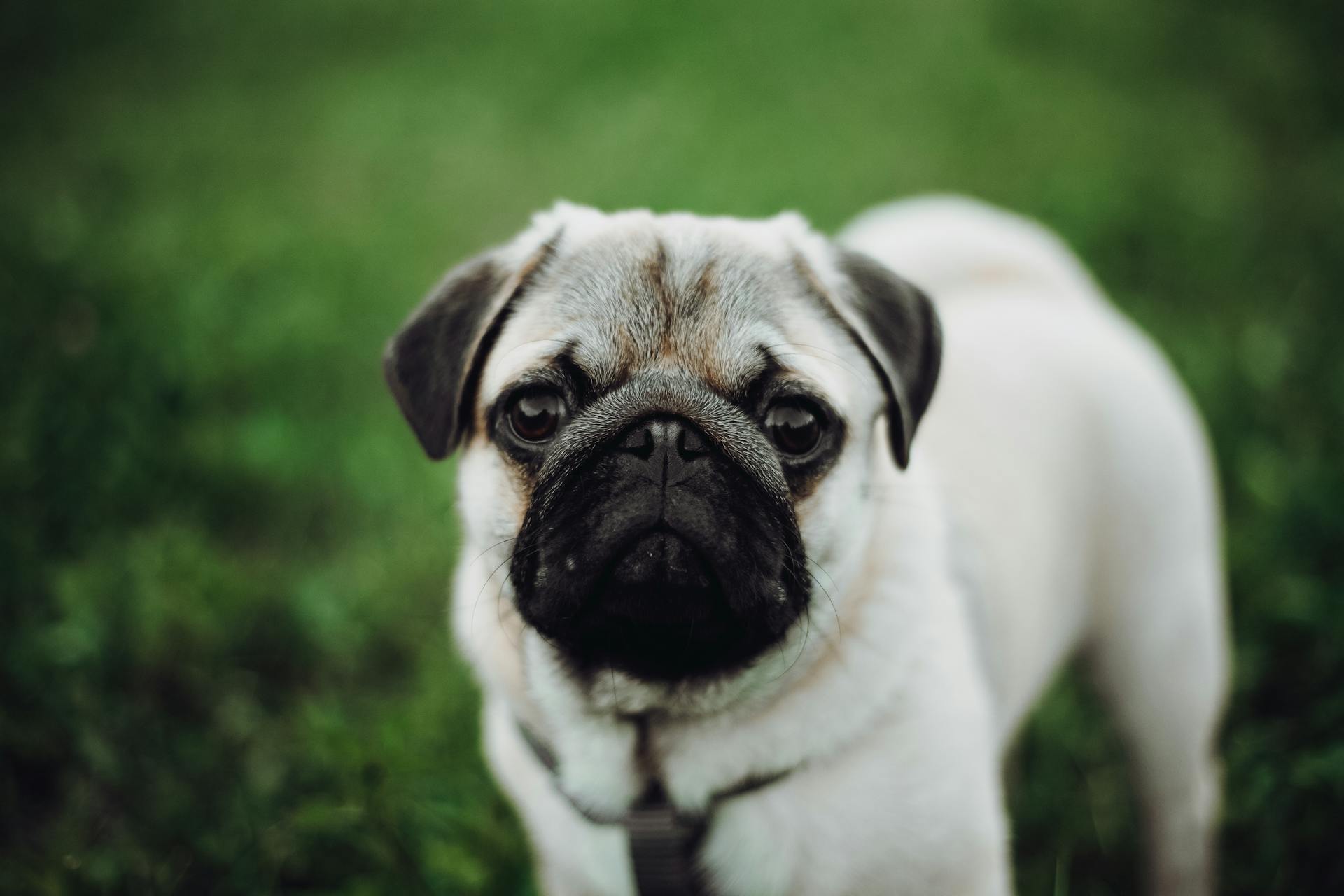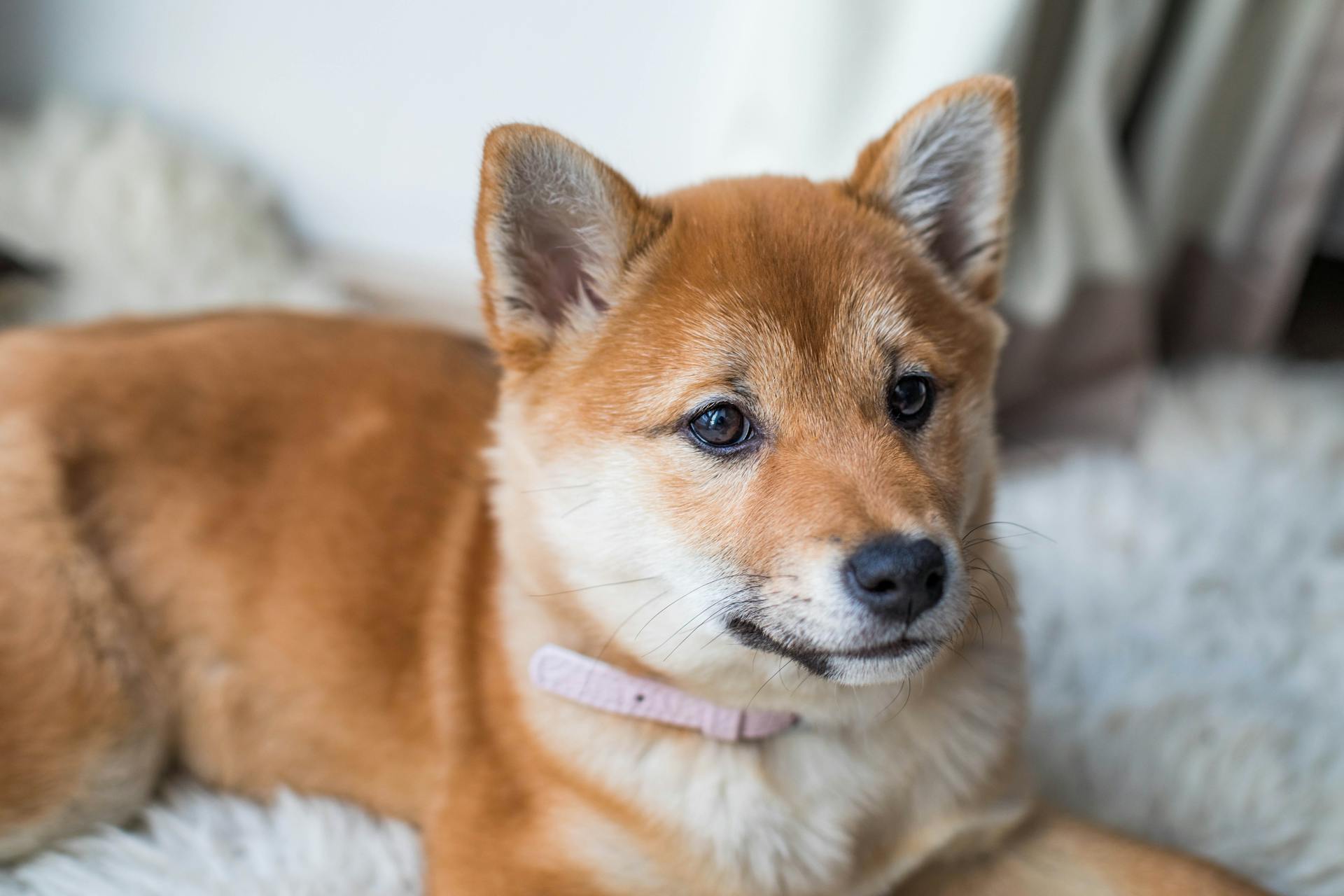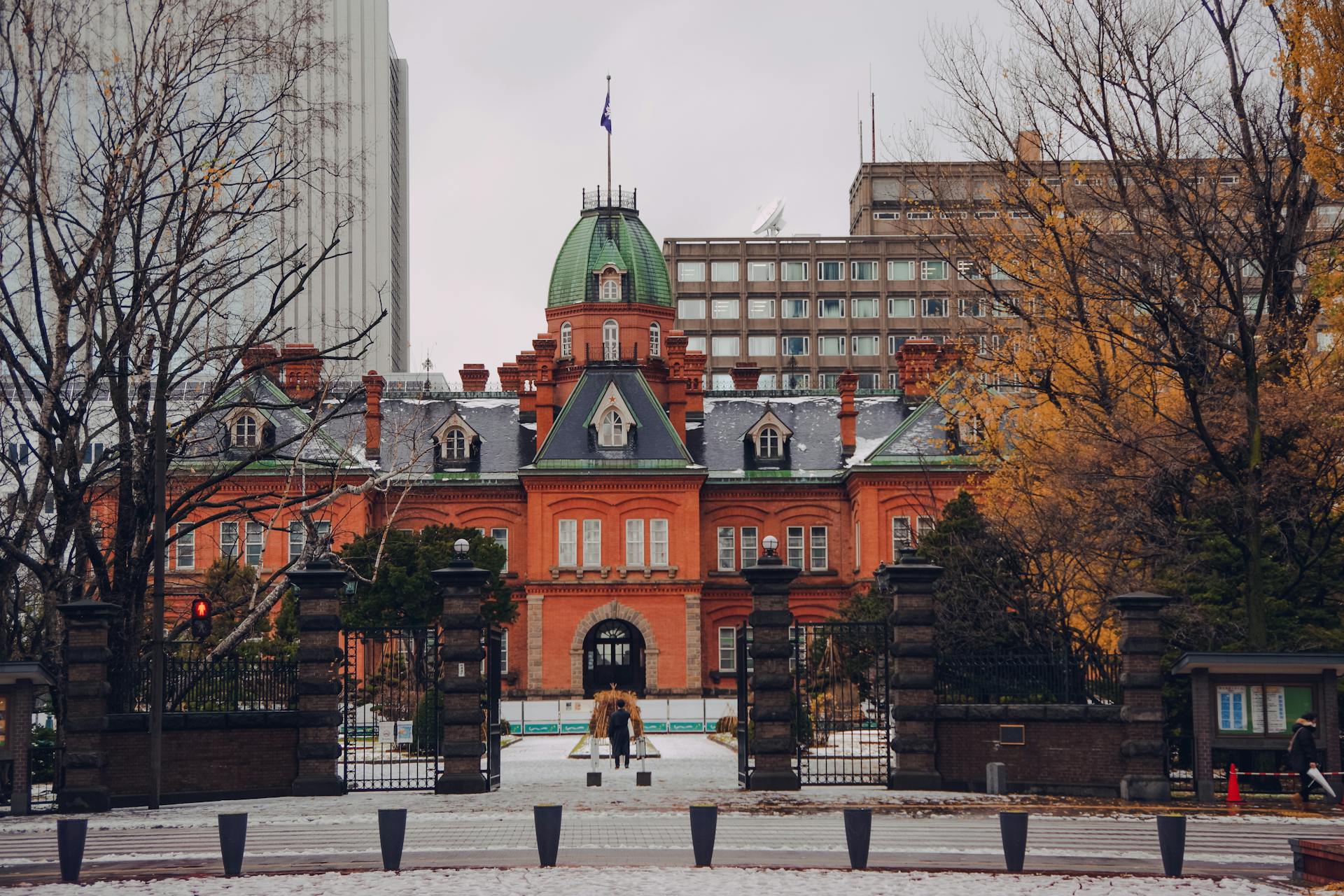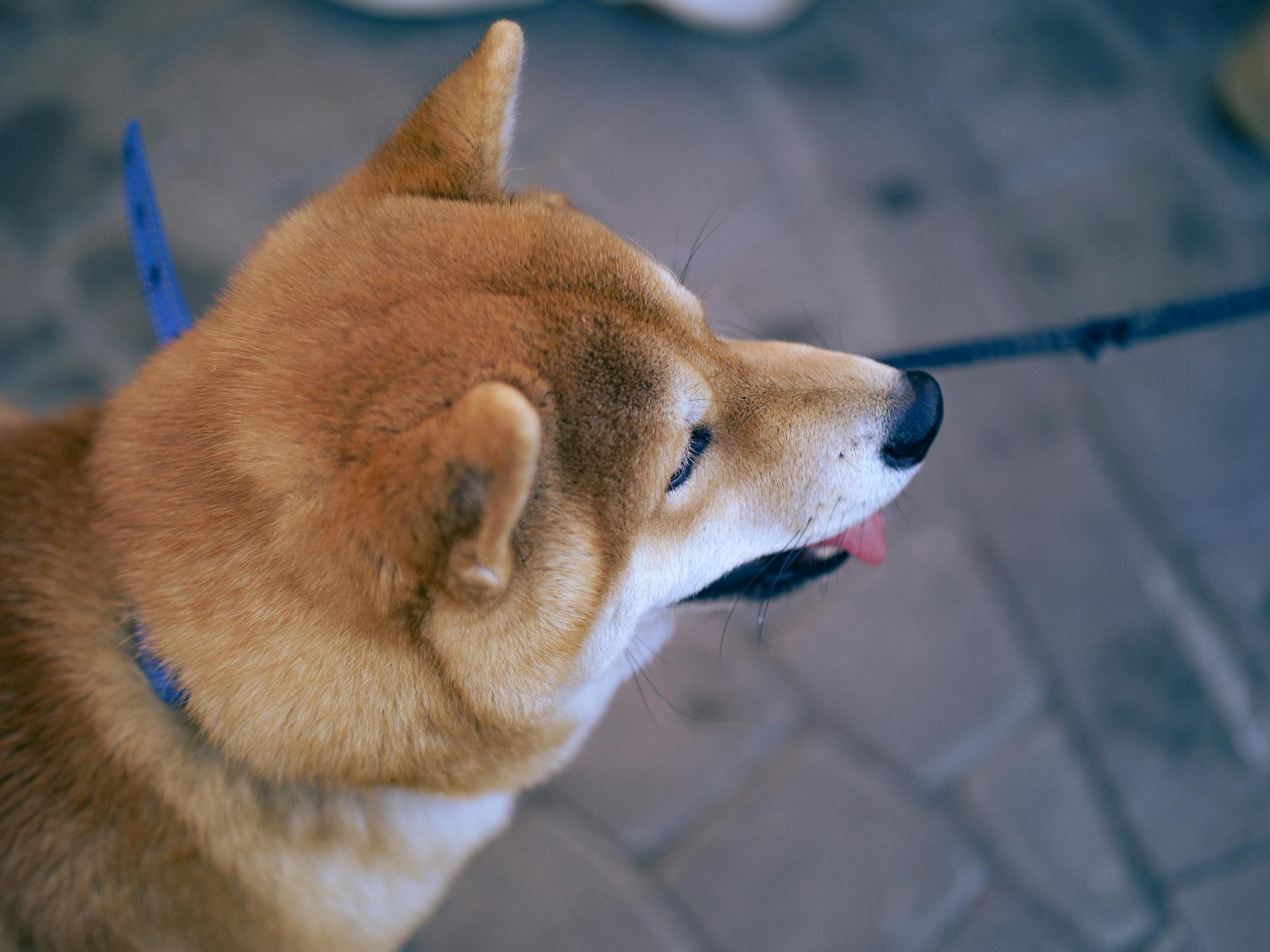
The Hokkaido Inu is an ancient breed originating from Japan, specifically bred to hunt large game such as bears and deer.
They are known for their distinctive appearance, with a thick double coat that can be black, brown, or white in color.
Hokkaido Inu puppies are born with their eyes closed, and they typically open them around 7-10 days old.
Their large paws and strong build make them well-suited for navigating rugged terrain.
These puppies are known to be quite energetic, requiring regular exercise and playtime from an early age.
Their intelligence and loyalty make them excellent family pets, but they do require consistent training and socialization.
The average litter size for Hokkaido Inu puppies is 2-5 puppies, although larger litters have been known to occur.
Check this out: Hokkaido Inu Coin
Breed Information
The Hokkaido Inu is a medium-sized breed with a strong and athletic build, perfect for active families who love the outdoors.
They have a dense double coat that's well-suited for cold climates, making them a great choice for families who live in colder regions.
Their thick fur is also a signature feature, with a thick and fluffy plumed tail that's hard to miss.
Hokkaido Inus are highly intelligent and loyal, making them excellent companions for experienced dog owners.
They have a strong instinct to guard their family and territory, which can sometimes manifest as aloofness or wariness toward strangers.
To raise a well-adjusted Hokkaido Inu puppy, early socialization and consistent training are essential.
Here are some key characteristics to keep in mind when bringing a Hokkaido Inu puppy home:
- Muscular build: Hokkaido Inus have a sturdy build that's perfect for active families.
- Small-pointy ears: Their small ears are a distinctive feature of the breed.
- Large paws: Hokkaido Inus have large paws that are well-suited for their athletic build.
- Thick and fluffy plumed tail: Their signature feature is their thick and fluffy tail.
- High energy: Hokkaido Inus are a high-energy breed that requires regular exercise to stay happy and healthy.
Daily walks, play sessions, and access to a secure yard are essential to meet their needs.
Without sufficient exercise and mental engagement, they can become bored and potentially develop destructive behaviors.
Overall, Hokkaido Inus are a versatile and resilient breed that excels in a variety of roles, from a devoted family pet to a working dog in colder climates.
Physical Characteristics
Hokkaido inu puppies are a medium-sized breed, weighing between 45 and 65 pounds and standing between 18 and 22 inches tall.
Their muscular build and small-pointy ears give them a distinctive look. You can also identify them by their large paws and thick, fluffy plumed tail.
Their double coat is made up of a protective outer layer and a fine, dense undercoat that sheds seasonally. This means they need to be brushed daily during shedding season.
Here are the five main colors you can find in Hokkaido inu puppies: white, red, black and tan, brindle, and sesame.
Appearance
The Hokkaido dog is a medium-sized breed with a muscular build. They typically weigh between 30-65 pounds and stand between 18-22 inches tall.
Their ears are small and pointy, standing erect and at a right angle to their brow. Dark brown eyes are small and triangularly set, often accompanied by blue-black tongues with black spots.
Hokkaido dogs have a harsh double coat that's straight, with a dense and soft undercoat that sheds seasonally. They require daily brushing during active shedding periods.
For more insights, see: Hokkaido Dog vs Shiba Inu
Their tail is a signature feature, thick and fluffy, curling over their back in a typical spitz style. The coat is medium-long, thick enough to keep them warm in cold weather.
Here are the five recognized colors of Hokkaido dogs:
- White
- Red
- Black and tan
- Brindle
- Sesame
Note: Wolf gray is a rare color variation.
Coat
The Hokkaido's thick double coat is one of its most distinctive features. It's made up of a long and stiff outer coat and a shorter, softer undercoat.
The coat is designed to help the Hokkaido withstand Japan's harsh weather conditions. It sheds heavily, especially in the spring and fall, so regular grooming is essential.
Hokkaidos can come in a variety of colors, including white, red, black and tan, brindle, and sesame, with wolf gray being a rare occurrence. Their coat sheds seasonally, requiring daily brushing during this time.
To keep their coat in good condition, use a pin brush and metal comb for weekly brushing. This will help ensure that the undercoat is fully brushed.
Suggestion: Shiba Inu Coat
Health and Care
Hokkaido Inu puppies are generally healthy, but they can live with certain genetic disorders like collie eye anomaly, hip dysplasia, and heart murmurs. Regular check-ups with a veterinarian can help identify these issues early on.
Their average lifespan is 12-15 years, so with proper care, they can live a long and healthy life. It's essential to monitor their toys and environment for small pieces that could be ingested.
Hokkaido Inu puppies are prone to over-eating, so it's crucial to control their food intake and avoid overfeeding. A balanced diet of vet-recommended dry puppy food in 2-3 small meals a day can help prevent weight gain.
Check this out: Hokkaido Inu
Breed Maintenance
The Hokkaido breed requires regular grooming to manage their thick double coat.
They are a high-shedding breed, so you can expect to see a lot of loose hair.
Brushing them at least twice a week is essential to remove loose fur and prevent matting.
During shedding periods, you'll need to brush them more frequently to keep up with the amount of loose hair.
Consider reading: German Wirehaired Pointer Shed
It's best to use a pin brush and metal comb to ensure you're getting to their undercoat.
A deshedder can be a big help during shedding periods to make the process easier.
Bathing your Hokkaido is not a regular necessity, but rather a periodic one.
Three to four baths a year are recommended to loosen hair and remove dirt.
When you do bathe them, use a mild shampoo to avoid stripping their coat of its natural oils.
Their coat can take a long time to dry, so be patient.
Trimming their nails every two to three weeks or as needed will keep them neat and tidy.
Checking their ears weekly and cleaning as needed will help prevent infections.
A dental plan is crucial to keep their teeth and gums healthy.
Daily brushing of their teeth is ideal, but even a few times a week will make a big difference.
On a similar theme: Long Coat Chesapeake Bay Retriever
Lifespan
The Hokkaido dog has an average life expectancy of between 11 to 13 years. This means you can expect to spend around a decade and a half with your furry companion. With proper care, they can live a long and happy life.
Discover more: German Shorthaired Pointer Life Stages
Health
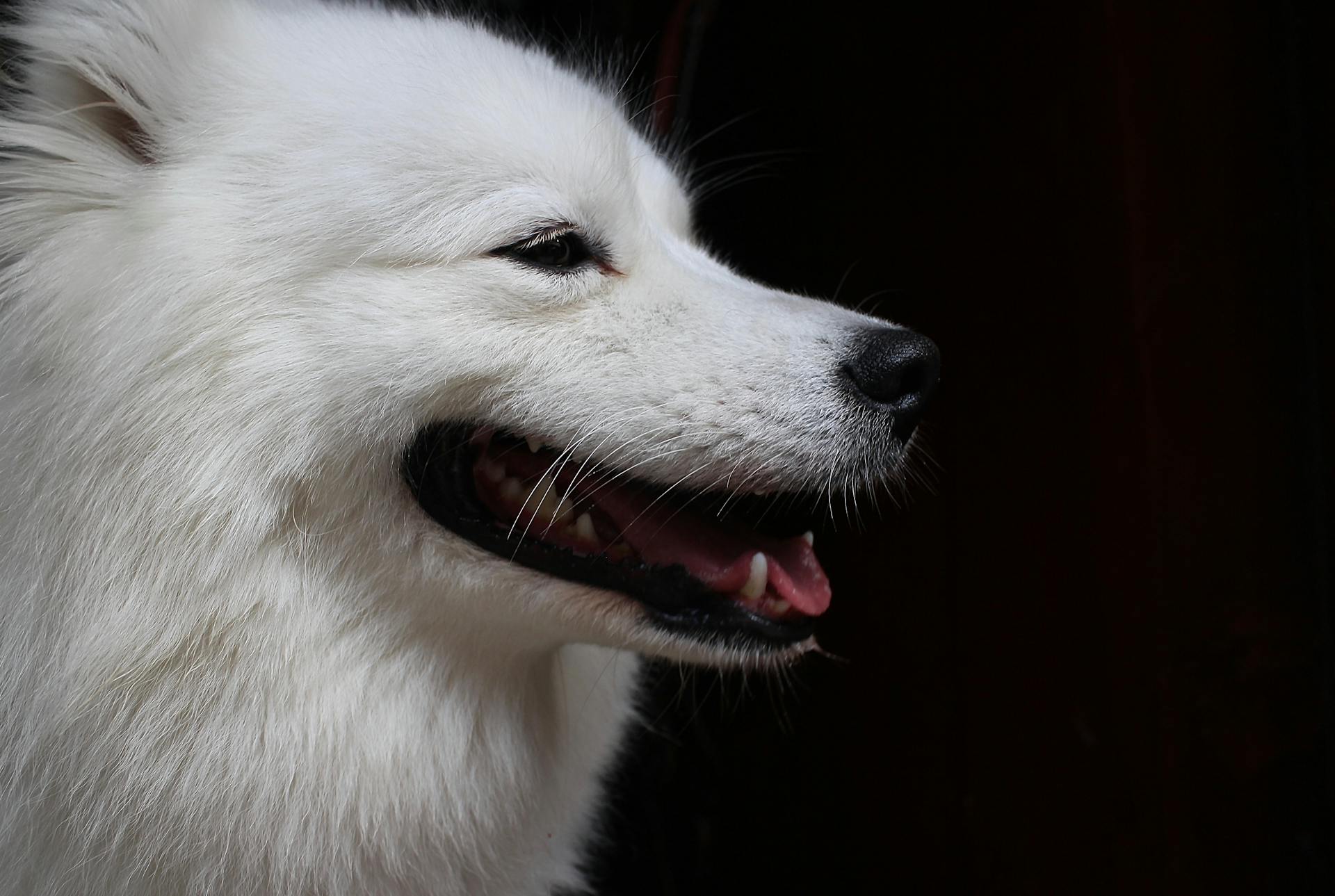
The Hokkaido breed is generally a healthy one, with an average lifespan of 12-15 years. They can live long and happy lives with proper care.
One genetic disorder to look out for is Collie Eye Anomaly (CEA), which can cause vision issues. A veterinarian can diagnose it with a simple eye exam, and a genetic test can be done on puppies to check if they carry the gene.
Hip dysplasia and heart murmurs are also potential genetic issues to test for. These conditions can be inherited, so it's essential to work with a reputable breeder who has done health checks on the parent dogs.
Pica, or the improper snacking on non-food objects, is another issue to monitor. This can include rocks, sticks, and other small items that can be hazardous if ingested.
Regular vet checkups are crucial to catch any health issues early on. Keep an eye on your dog's behavior and watch for signs of discomfort or pain.
Here are some common health issues to be aware of in Hokkaido dogs:
- Collie Eye Anomaly (CEA)
- Hip dysplasia
- Heart murmurs
- Pica
- Luxating patella
- Idiopathic seizures
- Psychogenic polydipsia
Dog Nutrition
As a Hokkaido Inu owner, it's essential to keep a close eye on their eating habits to prevent weight gain, which they tend to do easily.
Feed your Hokkaido Inu vet-recommended dry puppy food in 2-3 small meals instead of one big meal per day.
Avoid low-quality dog foods that contain fillers, artificial preservatives, and by-products, as they can lead to allergies and digestive problems.
Common allergens like corn, soy, and wheat can cause gastrointestinal distress or skin issues in sensitive Hokkaidos.
Foods high in artificial colors, flavors, and preservatives offer no nutritional benefit and can negatively impact your Hokkaido's health over time.
Raw or undercooked fish is a no-go, as it can contain parasites that pose a risk to your Hokkaido's health.
Human foods like chocolate, grapes, raisins, onions, and garlic are toxic to dogs and can lead to severe health issues.
Fatty and spicy foods should be avoided, as Hokkaidos can be prone to pancreatitis, a condition exacerbated by high-fat diets.
Behavior and Training
Hokkaido inu puppies are known for their fantastic trainability, loving to please their owners and learning commands quickly.
Positive reinforcement and reward-based training work best for Hokkaido, using verbal praise and treats.
They respond poorly to anger or frustration, so it's essential to keep training sessions calm and enjoyable.
Hokkaido are extremely intelligent and good with tasks, making them easy to train and pick up cues from their owners with ease.
They love to stick to their owners like glue and follow them around the house constantly, requiring regular walks and activity to burn off their energy.
Their bold personalities can be independent, but they do tend to listen to instructions given by their owners.
Worth a look: Dutch Shepherd Training
Things to Consider Before Owning a Dog
Owning a Hokkaido Inu can be a rewarding experience, but it's essential to consider their unique needs and characteristics. You might be surprised to learn that they're a very rare breed, making it challenging to find one, even in Japan, and the price tag can be quite high.
Grooming requirements are relatively low, but their long, dense coat requires regular brushing, which can take up some time. Be prepared to commit to regular grooming sessions to keep your Hokkaido Inu's coat healthy and clean.
Hokkaido Inus are prone to certain genetic disorders, such as CEA, hip or elbow dysplasia, luxating patella, and others. It's crucial to research these potential health issues and factor them into your decision to own a Hokkaido Inu.
You might want to consider the noise level of a Hokkaido Inu, as they're known to howl loudly, especially when they're excited or happy. This can be a consideration if you live in an apartment or have noise restrictions in your neighborhood.
If you're considering adopting a Hokkaido Inu, be aware that anxiety, idiopathic seizures, and psychogenic polydipsia are potential issues in this breed. Researching these conditions and understanding their implications can help you make an informed decision.
Here are some key factors to consider when researching a Hokkaido Inu:
- Research the breed's traits, requirements, and potential health problems.
- Find reputable sources, such as trustworthy breeders or local rescue organizations.
- Visit the breeder or adoption center to meet the dog and assess its health and living conditions.
- Ask for documentation, such as vaccination records and health certificates.
- Prepare your home and family for the dog's arrival, including necessary supplies and a safe living space.
Training
The Hokkaido breed is extremely devoted to their people and will learn commands quickly and easily, making them a great dog for first time owners.
They love to please their owners, so positive reinforcement and reward-based training is the way to go, including verbal praise and treats.
You should never get angry or frustrated with your dog when training, as this can cause them to not want to learn.
Hokkaido dogs are intelligent and respond well to training, so incorporate their training into their daily exercise routine to reinforce your leadership role.
They can be a stubborn dog at times, so consistency and patience are key.
With proper training, a Hokkaido will be an excellent family companion for families with older children.
A fresh viewpoint: How to Train a Dogo Argentino
Dog FAQs
Dogs are highly social animals and thrive on interaction with their human family, but they can also be prone to separation anxiety if left alone for too long.
You can reduce separation anxiety by gradually increasing the amount of time you spend away from your dog, starting with small increments of 5-10 minutes.
Dogs have a unique sense of smell, with some breeds having up to 300 million olfactory receptors compared to only 6 million in humans.
Consistency is key when training your dog, so establish a routine and stick to it.
Dogs learn best through positive reinforcement, such as treats and praise, rather than punishment or negative reinforcement.
A tired dog is a happy dog, and regular exercise can help reduce destructive behavior and improve overall mood.
Housebreaking can be a challenge, but it's essential to establish a routine and reward good behavior with treats and praise.
Frequently Asked Questions
What is the difference between Hokkaido and Shiba Inu?
The main difference between Hokkaido and Shiba Inu is their size, with Hokkaido being larger and more muscular. Despite their similar appearance, these distinct characteristics set them apart from one another.
Are Hokkaido dogs good pets?
Hokkaido dogs can make excellent family companions for experienced owners, but they may not be suitable for first-time owners or families with young children. With proper training and care, they can be loyal and loving pets.
What are some of the faults for Hokkaido?
Faults in Hokkaido dogs include a slightly overshot or undershot bite. A more severe bite issue can lead to disqualification.
Featured Images: pexels.com
